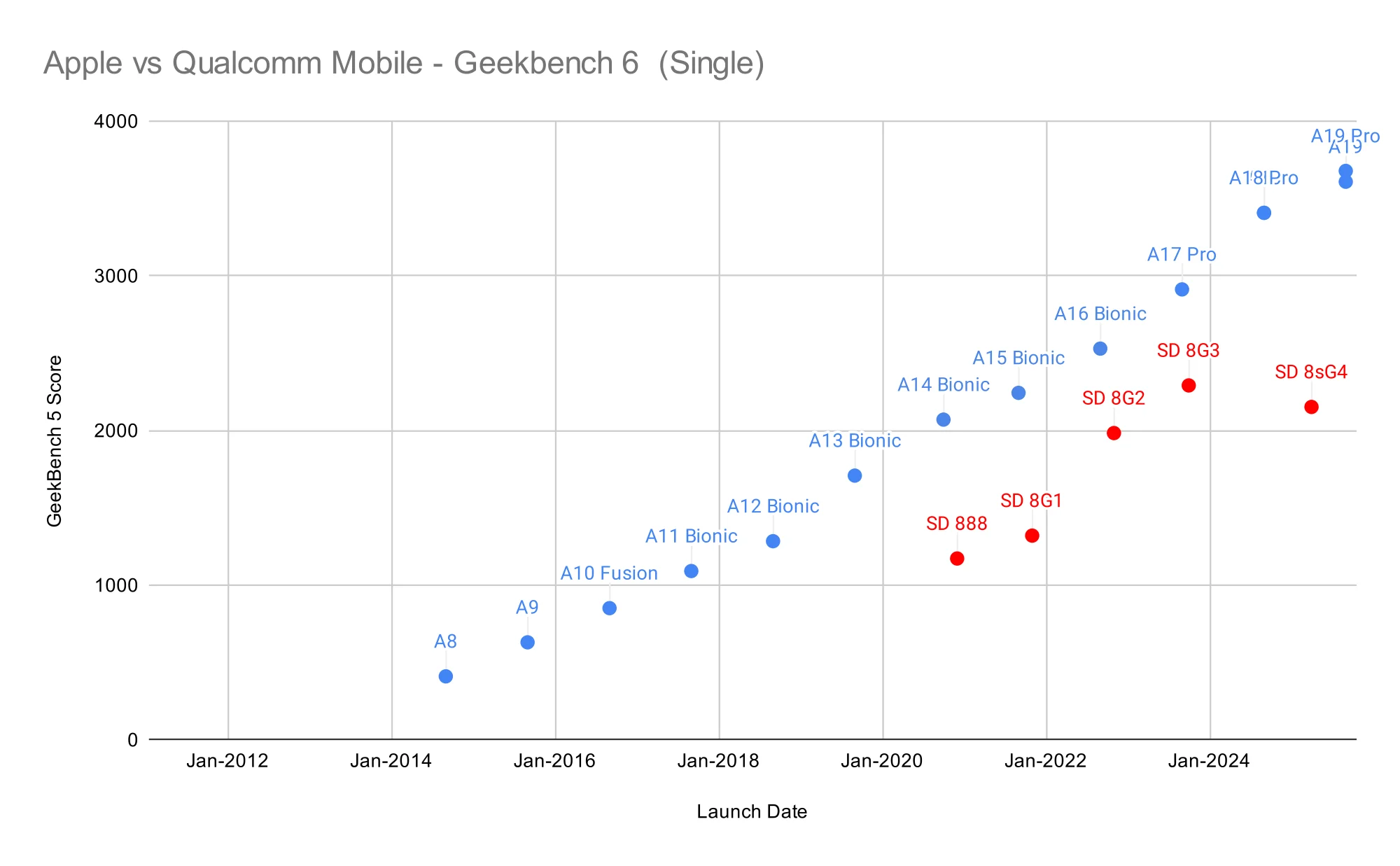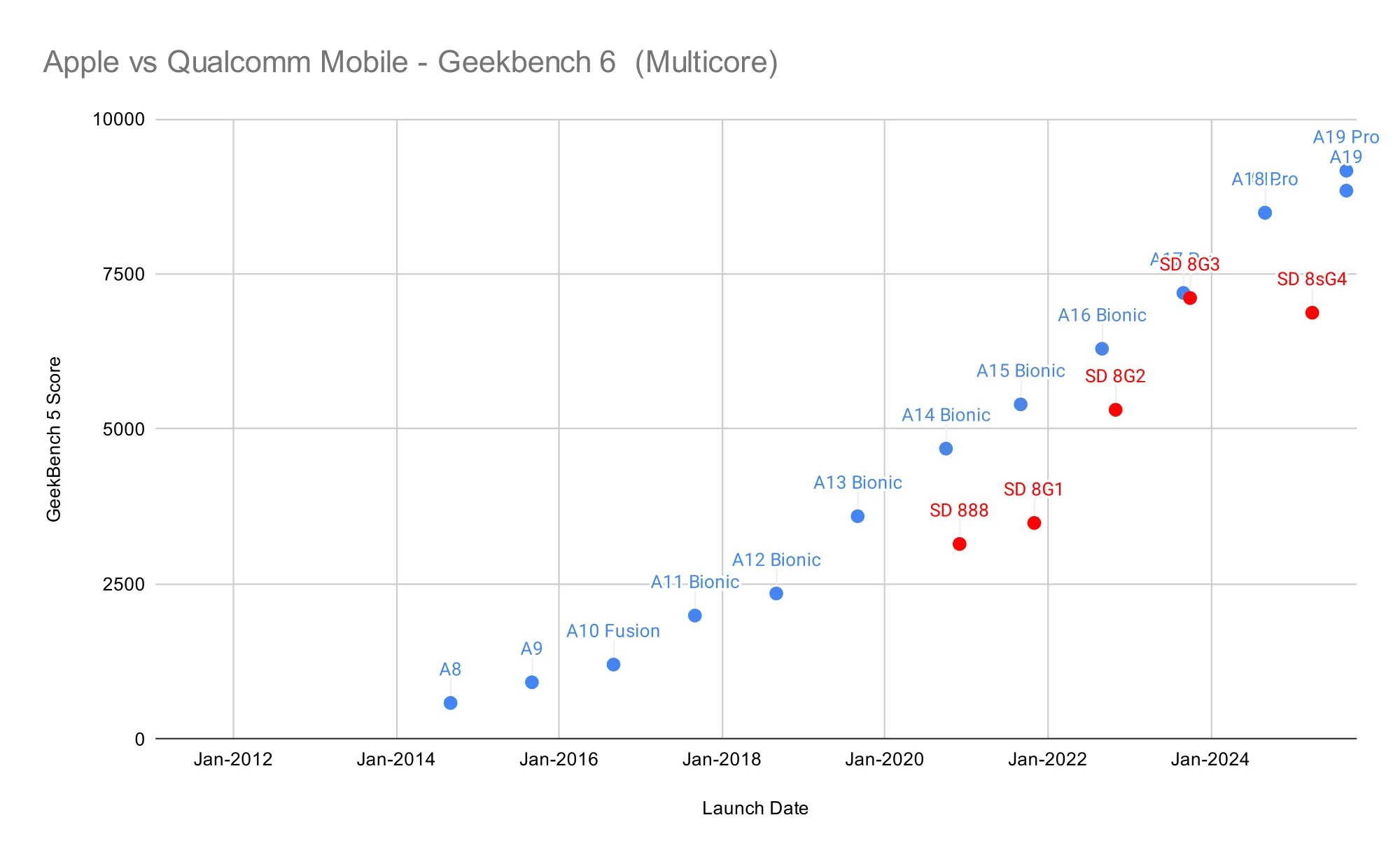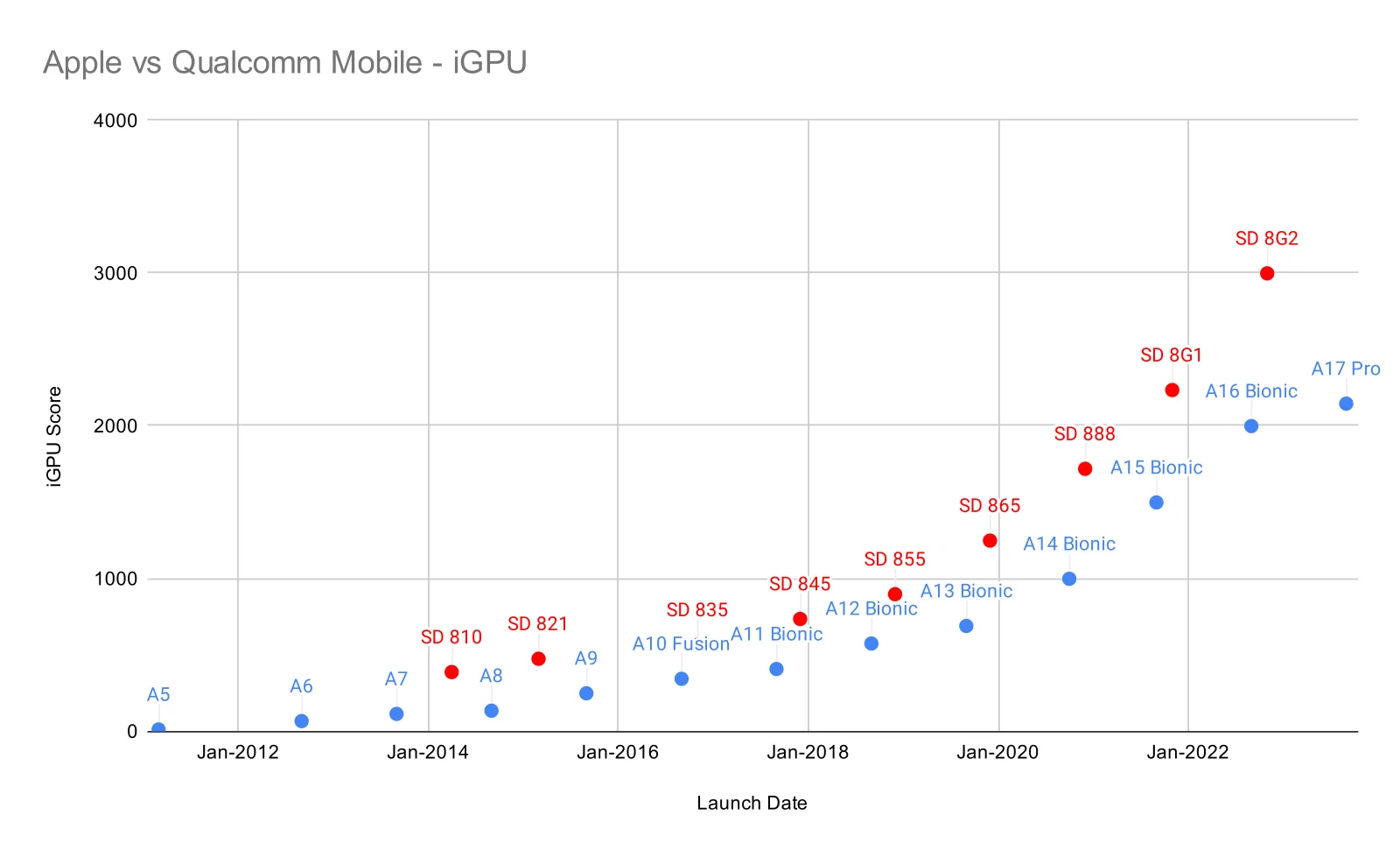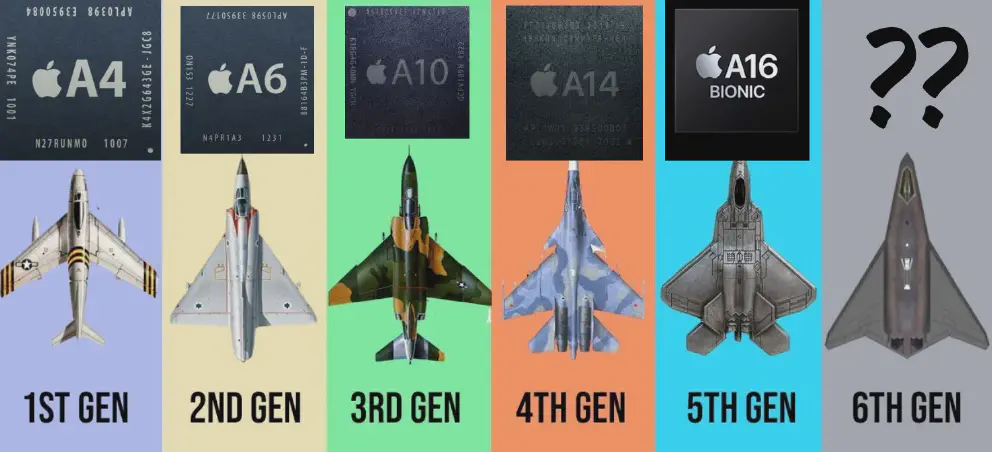| 2010 | A4 - 45nm construction; estimated 145 million transistors
- First Apple designed chip, but based on Cortex A8 processor
- 1 CPU core; PowerVR GPU SGX535
- Went into iPad 1, iPhone 4, iPod Touch 4, Apple TV 2
| S2 - 45nm construction
- 1 compute core, Adreno 205 GPU, Hexagon DSP
|
|---|
| 2011 | A5 - 45nm construction (later 32nm); estimated 200 million transistors
- Based on Cortex A9 chip
- Have a dedicated image signal processor
- 1 / 2 CPU cores; PowerVR GPU SGX543MP2
- Variants include A5X which went into iPad 3. A bigger GPU
- Went into iPhone 4s, iPad 2, iPad Mini, iPod Touch 5, Apple TV 3
| S3 - 45nm construction
- 2 compute cores (Scorpion), Adreno 220 GPU, Hexagon DSP
|
|---|
| 2012 | A6 - 32nm construction;
- First Apple designed chip. Based on ARMv7 instruction set.
- 2 compute cores, PowerVR SGX543MP3 GPU
- Went into iPhone 5 and iPhone 5c
- Variants includes A6X that is used in iPad 4
| S4 Pro - 45nm construction
- 2x compute cores (Cortex A5), Adreno 203 GPU, Hexagon DSP
- Bluetooth 3.0
|
|---|
| 2013 | A7 - 28nm construction; 1 billion transistors
- 2 CPU cores; PowerVR G6430 GPU
- Went into iPhone 5s, iPad Air 1, iPad Mini 2 and iPad Mini 3
- New: First 64-bit processor
- New: M7 motion co-processor
- New: ARMv8 instruction set
- New: Secure Enclave to keep encrypted data on chip. Used for TouchID
| SnapDragon 800 - Replaces the S-series as top of the line mobile SOC
- 28nm construction
- 4 compute (Krait) cores, Adreno 330 GPU, Hexagon DSP
- Bluetooth 4.0 support, 802.11ac Wi-Fi
|
|---|
| 2014 | A8 - 20nm construction; 2 billion transistors
- 2 CPU cores; PowerVR 6XT GPU
- Went into iPhone 6, iPod Touch 6, iPad Mini 4, Apple TV 4, HomePod,
- Morphs into A8X which went into iPad Air 2
- New: custom shader cores by Apple
- Subject of a ligitation between Apple and University of Wisconsin
| SnapDragon 808/810 - 20nm construction. 2.5 billion transistors.
- 6 compute (2 performance + 4 efficiency) cores, Adreno 430 GPU, Hexagon V56 DSP
- SnapDragon 810 has 8 compute (4 + 4) cores
- First 64-bit mobile processor from Qualcomm
- X10 LTE internal modem. Supports Bluetooth 4.1 and 802.11ac Wi-Fi
|
|---|
| 2015 | A9 - 16nm / 14 nm construction. 2 billion transistors
- 2 CPU cores, PowerVR GPU 7XT
- Went into iPhone 6s, iPhone SE, iPad 5
- M9 motion co-processor
- New image processor
- New: dedicated crypto engine to storage encryption
- Chipgate: alledge that Samsung fabricated A9 chip has a shorter battery life
- First SOC to support ARKit
| |
|---|
| 2016 | A10 Fusion - 16nm construction; 3.3 billion transistors
- 4 compute cores: 2 performance + 2 efficiency; PowerVR 7XT GT7600 series GPU; Some of the graphic shaders is custom made.
- Performance controller to decide which task is best suited for with compute cores
- Went into iPhone 7, iPod Touch 7, iPad 6 and iPad 7
- Variant into T2 SOC which used in Apple Macs for TouchID, storage encryption and media processing
- Other variant includes A10X Fusion which runs the iPad Pro 2
- Adds HEIF and HEVC hardware encoding
- M10 motion co-processor
- New: first quad-core chip by Apple
- New: 64-bit ARM chip by Apple. First in the industry to introduce 64-bit in ARM
- New: InFO packaging
| SnapDraogn 820/821 - 14nm FinFET construction. 2.0 billion transistors.
- 4 compute cores, Adreno 530 GPU, Hexagon 680 for AI workload, Spectra ISP
- X12 LTE modem, 802.11ad Wi-Fi support.
|
|---|
| 2017 | A11 Bionic - 10nm construction; 4.3 billion transistors
- 6 compute cores: 2 performance + 4 efficiency; 3 GPU cores, Unknown number of neural cores
- Went into iPhone 8 and iPhone X
- Updated performance controller which allows all compute cores can be used simutelously, instead of either performance or efficiency in the A10.
- New: M11 motion co-processor and new image processor to do computational photography (potrait mode)
- New: First Apple design graphic cores
- New: Neural Engine. First processor with Neural Engine. Dedicated to AI task like face recognition for Animoji and FaceID.
| SnapDraogn 835 - 8 compute cores (4 performance + 4 efficiency), Adreno 540 (4 cores) GPU, Hexagon 682 for AI workloads, Spectra 180 for ISP
- X16 internal modem. Supports LTE, 802.11 ad, and Bluetooth 5.0
|
|---|
| 2018 | A12 Bionic - 7nm FinFET construction; 6.9 billion transistors
- 6 compute cores: 2 performance + 4 efficiency; 4 GPU cores; 8 neural cores
- Went into iPhone Xs, iPhone 11, iPhone 11 Pro, iPad Air 3, iPad Mini 5, iPad 8, Apple TV 4K 2021
- Other variants includes A12X which runs on iPad Pro 2018 and A12Z which runs on iPad Pro 2020. They have 8 CPU cores, and the A12X has 7 GPU cores while the A12Z has 8 GPU cores. The A12Z also kickstart the Apple Silicon move in form of Developer Transition Kit, a Mac Mini with an A12Z as the CPU.
- New: FinFET process in manufacturing. First consumer product to do so.
| SnapDraogn 845 - 10nm FinFET construction
- 8 compute cores (4 performance + 4 efficiency), Adreno 630 (2 cores) GPU, Hexagon 635 for AI workloads, Spectra 280 for ISP
|
|---|
| 2019 | A13 Bionic - 7nm (N7P) construction; 8.5 billion transistors
- 6 compute cores: 2 performance, 4 efficiency; 4 GPU cores; 8 neural cores
- Went into iPhone 11, iPhone 11 Pro, iPad 9, iPhone SE 2, Apple Studio Display
- New: AMX accelerators. Helps with matrix calculations
| SnapDragon 855/855+ - 7nm (N7) construction
- 8 compute (1 prime + 3 performance + 4 efficiency) cores. Adreno 640 GPU, Hexagon 690 for AI, and Spectra 380 for ISP
- X25 internal modem, X50 external modem for 5G
|
|---|
| 2020 | A14 Bionic - 5nm (N5) construction; 11.8 billion transistors
- 6 compute coreS: 2 performance, 4 efficiency; 4 GPU cores; 16 neural cores
- 2nd generation AMX accelerators
- Went into iPhone 12, iPhone 12 Pro, iPad Air 4, iPad 10
- Morphs into M1 Processor which kickstart Apple Silicon Macs
| SnapDragon 865/865+ - 2nd Gen 7nm (N7P) construction
- 8 compute (1 prime + 3 performance, + 4 efficiency) compute cores, Adreno 650 GPU, Hexagon 698 for AI accelerators, Spectra 480 for ISP
- X55 internal modem. Support 5G and Wi-Fi 6 ready
- First to support 8K video recording
|
|---|
| 2021 | A15 Bionic - 5nm (N5P) construction; 15 billion transistors
- 6 compute: 2 performance, 4 efficiency; 4 or 5 GPU cores, 16 neural cores
- New: Media Engine to handle ProRes video files
- Went into iPhone 13, iPhone 13 Pro, Apple TV 4K (2022)
- Encoding support for HEVC and H.264. Decoding support for HEVC, H.265, MPEG-part 2, and Motion JPEG
| SnapDragon 888/888+ - 5nm (5LPE) construction. ~10 billion transistors.
- 8 compute cores (1 prime + 3 performance + 4 efficiency) cores, Adreno 660 GPU, Hexagon 780 AI accelerators, Spectra 500 for ISP
- X60 internal modem. Support 5G, Bluetooth 5.2, WiFi-6 ready
- Supports HDR content playback
|
|---|
| 2022 | A16 Bionic - 4nm (N4) construction; 16 billion transistors. Some say it's the 3rd generation 5nm construction.
- 6 compute: 2 performance, 4 efficiency, 5 GPU cores, 16 neural cores
- New: Display Engine. Handle always on display on the iPhone 14 Pro, high peak brightness.
- Introduced on the iPhone 14 Pro only
| SnapDragon 8 Gen 1/ SnapDragon 8+ Gen. 1 - 4nm (4LPE) construction
- 8 compute cores (1 prime + 3 performance + 4 efficiency core), Adreno 730 GPU, Hexagon AI cores
- Supports ARMv9 instruction set.
- Spectra cores for Image Signal Processing
- Internal X65 modem, 5G support, Wi-Fi 6 ready
SnapDragon 8 Gen 2 - 4nm construction
- Announced in Nov 2022 with Smartphones fielding in Dec 2022
- 8 compute cores (1 prime Cortex X3 + 4 performance + 3 efficiency cores), Adreno GPU, Hexagon AI cores. Re-arranged the amount of performance cores to give a higher multi-core performance
- Legacy 32-bit apps only use the efficiency cores
- Cognitive ISP for cameras.
- Hexagon AI cores supports INT4 format
- Supports LPDDR5X memory
- Internal X70 modem, 5G supports, Wi-Fi 7 ready, Bluetooth 5.3
|
|---|
| 2023 | A17 Pro - 3nm construction; 19 billion transistors;
- 6-Core CPU (2x P, 4x E); 6-Core GPU; 16-Core Neural Core;
- Redesigned GPU, have Mesh Shading & Ray-tracing accelerator; Metal effects upscaling.
- ProRes decoder, Pro Display engine; New: AV1 decoder
- New: USB 3 Control Module
- Introduced for iPhone 15 Pro only
| SnapDragon 8 Gen 3 - Launched in October '23
- 8-Core CPU (1x Prime, 5x performance, 2x efficiency cores); New Adreno GPU, Hexagon DSP for AI
- Two of the performance cores clocked higher than the other performance cores
- 4nm TSMC N4P manufacturing process
- Qualcomm claimed 30% faster CPU performance, 25% graphic performance and 98% faster AI performance while at least 25% more power efficient
- Uses SnapDragon X75 5G Modem
- Dual Frequency GNSS support
|
|---|
| 2024 | A18 Pro - Launched in September 2024
- 2nd generation 3nm construction
- 6-core CPU, 6-core GPU, 16-core Neural Engine
- Mesh Shading, Ray Tracing acceleration, Metal effects upscaling
- ProRes decoder, Pro Display Engine, AV1 decoder
- Introduce for iPhone 16 Pro models
- New: ARM9 instruction set support
- Faster ray-tracing, higher memory bandwidth
- Based on the M4 designs
A18 - Launched in September 2024
- 2nd generation 3nm construction
- 6-core CPU, 5-core GPU, 16-core Neural Engine
| SnapDragon 8 Elite - Launched in October 2024
- 3nm construction
- New 2nd-gen Oryon CPU (2 primes, 6 high performance cores), Adreno 830 GPU, Hexagon NPU
- Supports Wi-Fi 7, 5G, Bluetooth 6.0
- Memory support up to 24 GB
|
|---|
| 2025 | A19 Pro - Launched on September 2025
- 3rd generation 3nm construction
- 6-core CPU, 5 or 6-core GPU, 16-core Neural Engine
- Neural Accelerators in GPU cores
- Larger L2 or L3 cache
- Vapor Chamber cooling on iPhone 17 Pro
- Improved performance across the board
- 40% better sustained performance
- Introduced on iPhone 17 Pro and iPhone Air
A19 - Launched on September 2025
- 3rd generation 3nm construction
- 6-core CPU, 5-core GPU, 16-core Neural Engine
- Introduced on iPhone 17
| SnapDragon 8s Gen 4 - Launched in April 2025
- 4nm construction
- 8-core CPU, Adreno 825 CPU, Spectra image processor
SnapDragon 8 Elite Gen 5 - Launched in September 2025
- 3rd gen Oryon CPU. 4.6 GHz peak clock speed. 2 prime cores, 6 performance cores
- Adreno GPU. Unreal Engine 5 optimization. Adaptive Game configuration.
- AI Engine with Hexagon NPU
- X85 5G Modem. Supports 5G mmWave, sub-6 GHz, and other modes
- FastConnect 7900 Mobile Connectivity System. Wi-Fi 7 supports (6GHz, 5GHz, 2.4GHz band). AI-enhanced Wi-Fi
- Snapdragon Sound Technology Suite
|
|---|



